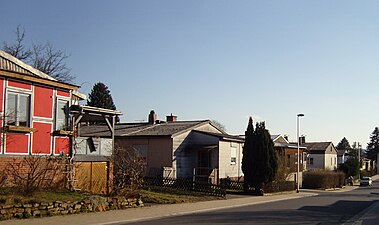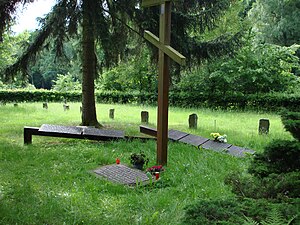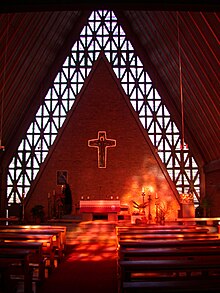Trutzhain
|
Trutzhain
City of Schwalmstadt
Coordinates: 50 ° 54 ′ 10 ″ N , 9 ° 16 ′ 26 ″ E
|
|
|---|---|
| Height : | 227 m above sea level NHN |
| Area : | 50 ha |
| Residents : | 728 (December 31, 2018) |
| Population density : | 1,456 inhabitants / km² |
| Incorporation : | December 31, 1970 |
| Postal code : | 34613 |
| Area code : | 06691 |
|
Trutzhain from the east
|
|
The village of Trutzhain has been part of Schwalmstadt in the north Hessian Schwalm-Eder district since December 31, 1970 . In 1948 the former prisoner-of-war camp Ziegenhain became the refugee settlement Trutzhain. On April 1, 1951, Trutzhain became the youngest Hessian community at the time.
history
Origin as a prison camp
During the Second World War , the Nazi regime set up the main camp IX A for prisoners of war (September 1939 to March 1945) in the area of today's Trutzhain . The camp consisted initially only of tents, from the end of 1940 then from solid truss - barracks for a total of 6,000 to 8,000 prisoners. Among these from 1940 to 1941 was the future French President François Mitterrand .
The Soviet prisoners of war in StaLag IX A had little chance of survival. Most died from malnutrition and infection. Some of the bodies were buried in the nearby forest. A memorial for the dead of the camp is located on the forest cemetery, which was created later, at the approximate location of the Trutzhain settlement, which fell into desolation in the Middle Ages .
After the camp was liberated on March 30, 1945, the camp was initially used by the US Army as Civil Internment Camp 95 (CIC 95) to accommodate members of the Waffen SS , the NSDAP , SA and SS , Wehrmacht soldiers and women. The camp existed until the summer of 1946.
At the beginning of August 1946, the US Army set up DP camp 95-443 Ziegenhain in the empty barracks . For the Displaced Persons (DP) it became a transit station for the longed-for departure to Palestine , Great Britain , Canada, Australia, South America or the USA. The average number of records in the DP camp, which was closed at the end of November 1947, was 2000 people. A TBC sanatorium near Steina was attached to the camp from 1946 to 1947 , in the former Reichseminar of the National Socialist People's Welfare (NSV) for the training of kindergarten teachers and after- school care workers, where the Steinatal school settlement with the Melanchthon School has existed since 1950 .
Views of the former Trutzhain camp
Trutzhain is founded
In January 1948, the then district of Ziegenhain leased the site of the former STALAG IX A for five years in order to offer accommodation to refugees and displaced persons from Silesia , East Prussia , West Prussia , Pomerania , the Sudetenland and other areas in the east. The first inductions took place in the spring of 1948. Within a short time, the “refugee settlement” developed into a flourishing handicraft, commercial and industrial location, the first commercial area in the Ziegenhain district. The place was given the nickname “Ruhrpott der Schwalm” because around 500 refugees and displaced persons set up businesses in a very short time and created over 200 jobs.
On April 1, 1951, the former camp became an independent municipality. Its district, only 50 hectares in size, was formed from part of the Steina district, and it was named after the nearby deserted Trutzhain .
As part of the regional reform in Hesse , on December 31, 1970, the two cities of Treysa and Ziegenhain merged with the surrounding villages of Ascherode, Florshain, Frankenhain, Niederbegrenzebach, Rommershausen and Trutzhain on a voluntary basis to form the expanded city of Schwalmstadt. This made Ascherode a district of Schwalmstadt. The administrative seat became Treysa. For all formerly independent municipalities, local districts with local advisory boards and local councilors were formed in accordance with the Hessian municipal code.
The main street of the village is still lined today by the former warehouse barracks, which have now been refurbished and serve as residential buildings. Due to their privatization to the expellees, the buildings have been preserved to this day. Since 1983 there has been a memorial with a museum in Trutzhain, which documents the past of the place. It is supervised by a historian and a group of volunteers.
Culture and sights
For the cultural monuments of the place see the list of cultural monuments in Trutzhain .
Church life and customs
Since 1949/1950, the Quinau pilgrimage has been celebrated in Trutzhain on the first Sunday in July . Displaced persons from Komotau ( Czech Republic ) had already brought this pilgrimage with them to Trutzhain at the time of the refugee settlement, even before the community was established. In the previous church of the Maria-Hilf-Kirche , which they set up in a barracks as early as 1949 , the miraculous image of the pregnant Madonna could be seen; since 1965 it has been in the new church building that was consecrated that year. In 2006 the parish association Maria Hilf Schwalmstadt was formed; it includes four Catholic parish curatios and three pastoral care offices in the Altkreis Ziegenhain district. The Quinau pilgrimage in Trutzhain has also been a joint pastoral pilgrimage since then. The pilgrimage is celebrated in Trutzhain and in Květnov in the Czech Republic , and both parishes are in contact with each other. Trutzhain as a place of pilgrimage and the Maria-Hilf-Kirche as a pilgrimage church are recognized by canon law. The establishment of a small monastery by the Order of the Oblati Mariae Immaculatae in Schwalmstadt-Ziegenhain in 2009 can be traced back to the pilgrimage in Trutzhain.
The Protestant parish first met in an improvised camp church and was able to inaugurate its newly built church in 1957. The "Evangelical rectory Steinatal in Trutzhain" established by the Evangelical Church of Kurhessen-Waldeck (EKKW) was also responsible for the nearby village of Steina and for the EKKW's Steinatal Melanchthon School.
Trutzhain is the seat of the Hessen branch of the Moravian-Silesian Sudeten Mountains Association . The Hergertsmühle hiking home in the Knüllgebirge near Neukirchen -eigertshausen also belongs to it.
Peace and reconciliation
Former opponents of the war shook hands in 1970 in the pilgrimage church of Maria-Hilf as part of an ecumenical festival service. Former French prisoners of war visited Trutzhain for the first time at the invitation of the Kyffhäuserkameradschaft Trutzhain. Since then, many contacts have been made between displaced Trutzhainern and former French prisoners of war. The “Museum for Peace” was created in 1983 through this collaboration.
Due to the displaced pilgrims, contacts between the Trutzhain parish and those in Görkau / Jirkov and Komotau developed early on . After the fall of the Iron Curtain in 1990, expellees made a pilgrimage to Quinau / Květnov again . In 2005 a youth group from the Komotau district visited Trutzhain for the first time . In 2008 a priest from Květnov took part in the pilgrimage in Trutzhain for the first time.
Corresponding reconciliation work and contacts with the families of the citizens of the USSR who perished in the camp were more difficult. Attempts to determine the names of the Soviet camp inmates only began late. Due to church memoranda and the federal government's Ostpolitik in the 1970s, the first meetings took place.
Personalities
- Martin Grzimek (born April 8, 1950 in Trutzhain), writer
- Horst Munk (†), 2003 Federal Cross of Merit of the Federal Republic of Germany for reconciliation between former opponents of the war
- Pierre Dentin (born August 12, 1911; † May 9, 2000), prisoner of war, pastor and confidante of the French prisoners of war and initiator of the reconciliation between the French prisoners of war and the expellees from Trutzhain, co-founder of the Museum for Peace in Trutzhain 1983, awarded the Federal Cross of Merit of the Federal Republic of Germany 1985, street name "Abbé-Pierre-Dentin-Allee" 2001.
literature
- Andreas Kossert : Kalte Heimat The history of the German expellees after 1945. Siedler Verlag, Munich 2008, ISBN 978-3-88680-861-8 .
- Martin Grzimek: Trutzhain, a village. Carl Hanser Verlag, 1984, ISBN 3-446-14001-8 .
- Filz, Ley, Munk, Scholz, Steidl; City of Schwalmstadt (ed.): Chronicle of Trutzhain 1951–2001. 2001.
- Martha Kent: A porcelain shard in the ditch - a German refugee childhood. Fischer Verlag, 2nd edition 2004, ISBN 3-596-16442-7 .
- Catholic Parish Curate Maria-Hilf (Ed.): Quinauer Pilgrimage in Trutzhain. 2003.
- Corinna Wagner: Trutzhain Memorial and Museum . Federal Agency for Civic Education, 2013.
- HW & M. Gömpel: ... arrived! Distributed from the Sudetenland - recorded in North Hesse , Preußler-Verlag, Nuremberg, 3rd edition, 2017, ISBN 978-3-934679-54-2
- Literature about Trutzhain in the Hessian Bibliography
Web links
- Trutzhain district. In: Website of the city of Schwalmstadt.
- Trutzhain, Schwalm-Eder district. Historical local dictionary for Hessen. (As of December 16, 2014). In: Landesgeschichtliches Informationssystem Hessen (LAGIS).
Individual evidence
- ↑ Numbers / data / facts. In: website. City of Schwalmstadt, accessed August 2020 .
- ↑ Population figures on December 31, 2018. In: website. City of Schwalmstadt, accessed August 2020 .
- ↑ Trutzheim Memorial
- ^ Steinatal, Reich Seminar of the National Socialist People's Welfare Association. V. (NSV). Topography of National Socialism in Hesse. In: Landesgeschichtliches Informationssystem Hessen (LAGIS).
- ↑ The entrance gate was made by unknown French prisoners of war between 1940 and 1945.
- ↑ Formation of an independent community Trutzhain in the district of Ziegenhain, Reg.-Bez. Kassel from April 1, 1951 . In: The Hessian Minister of the Interior (Ed.): State Gazette for the State of Hesse. 1951 no. 5 , p. 50 , point 81 ( online at the information system of the Hessian state parliament [PDF; 2.6 MB ]).
- ↑ grouping of municipalities to the city "Schwalmstadt" County goat Hein of 7 January 1971 . In: The Hessian Minister of the Interior (ed.): State Gazette for the State of Hesse. 1971 No. 4 , p. 139 , point 158 ( online at the information system of the Hessian state parliament [PDF; 6.3 MB ]).
- ↑ main statute. (PDF; 314 kB) § 5. In: Website. City of Schwamstadt, accessed August 2020 .
- ↑ Pilgrimage Church of Maria-Hilf Trutzhain











